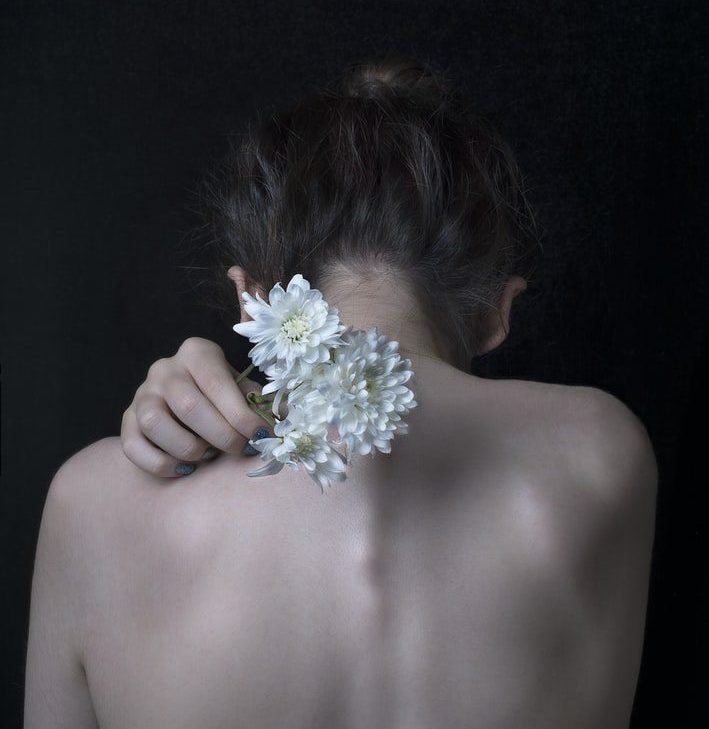AUTUMN’S FLOWERS
Their Character, Beauty—and Meaning
Down through the ages, flowers have been ascribed symbolic meanings. Shakespeare incorporated the language of flowers surreptitiously in his writings. Ancient cultures—Greek, Roman, Egyptian, and Chinese—used Nature’s vernacular in their myths, sonnets, plays, and folklore.
The Victorians were especially keen on this special symbolism, and many kept a journal alongside their Bible to decipher the language. A flower could deliver a secret message, one that need not be spoken, but was as powerful as the spoken word. Even the manner in which a flower was handed to a person had meaning. For example, if you handed a flower to your lover with your right hand, it meant “yes” but if you used your left, it meant “no.”
Even in motion pictures, flowers were used to emphasize the meaning of a scene. For example, few performances utilized the language of flowers more poignantly than Katherine Hepburn’s role in Stage Door (1937), when she spoke one of her most famous lines: “The calla lilies are in bloom again.” The calla lily means purity, beauty, and loss and was the perfect choice as Hepburn deals with the tragic news that a fragile young woman who roomed at her boarding house had just committed suicide. Here are some of autumn’s flowers and a glimpse of their character, beauty, and the special meanings that you, too, can learn from the book, Language of Flowers.
Autumn Language of Flowers
PANSIES
thinking
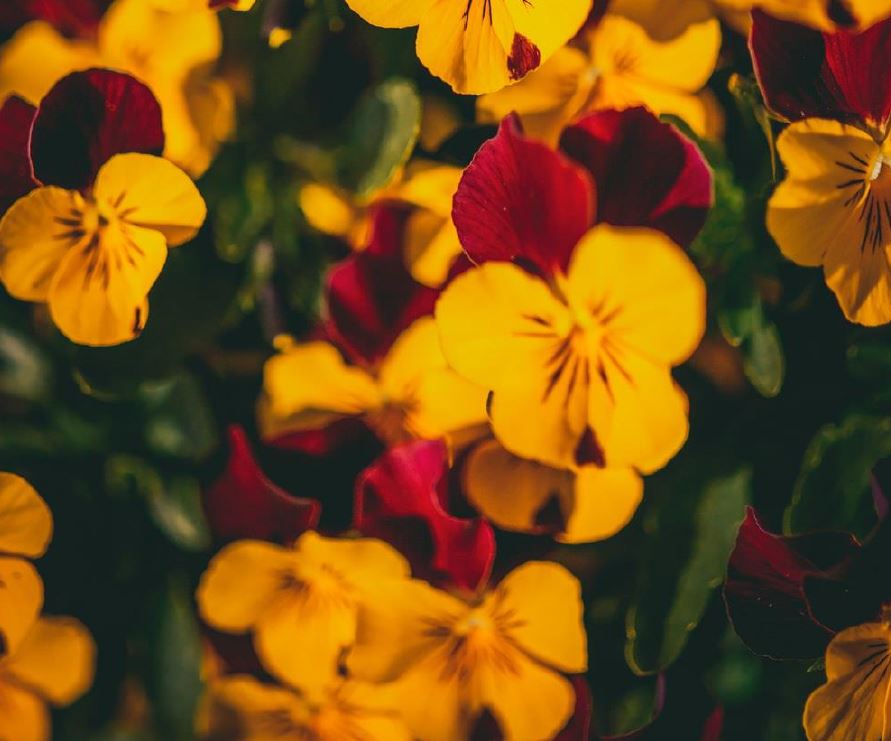 In the Language of Flowers, pansies mean “thinking.”
In the Language of Flowers, pansies mean “thinking.”
The word itself comes from French pensée, which means “thought.”
Shakespeare used the language of flowers to add meaning to his storylines. In Hamlet, for example, ill-fated Ophelia laments, ”There’s rosemary, that’s for remembrance; pray, love, remember: and there are pansies, that’s for thoughts.”
Although this hardy flower blooms year-round, it thrives best in the North in the fall and, in the South, all through snowless winters. Pansies come in a veritable palette of colors—blue, orange, pink, purple, red, white, yellow. Low-growing and dense, they make a lush border or ground cover. Plant pansies in a container with primroses, trailing lobelia, or sweet alyssum as a showpiece on your patio or by your front door.
CHRYSANTHEMUMS—or, more familiarly, MUMS
“The birth flower of November”
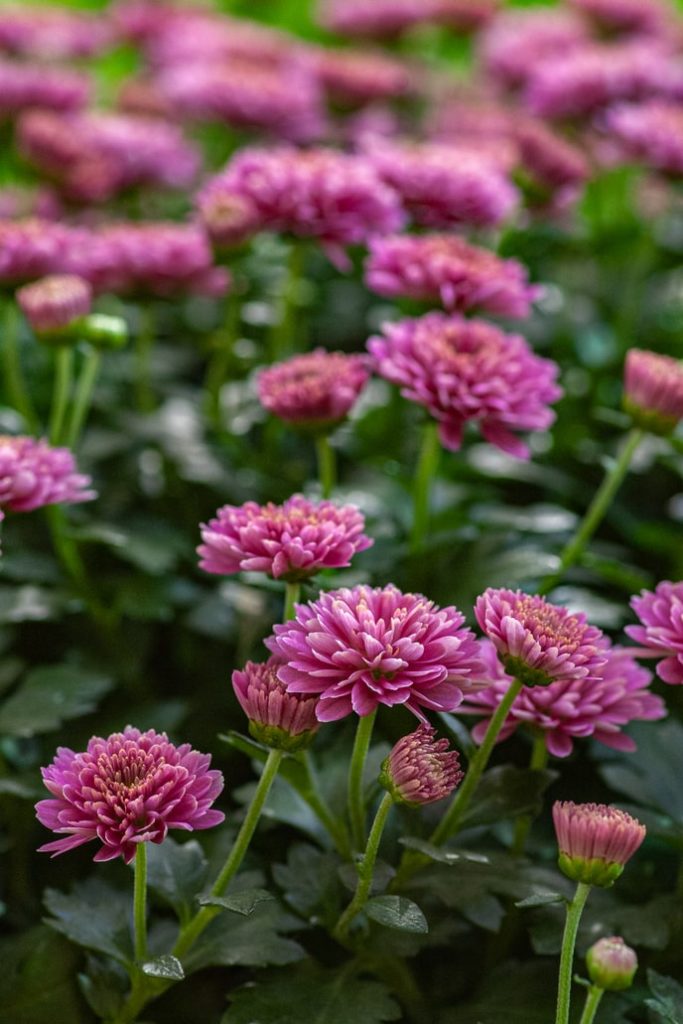 THE WORD “CHRYSANTHEMUM” comes from the Greek prefix chrys, which means “golden” and anthemion, which means “flower.” Originally yellow and golden, mums come in many colors. In the Language of Flowers, red chrysanthemums mean “I love you.” White chrysanthemums mean innocence, purity of nature, and pure love. The yellow mum means “slighted love.” American writer John Steinbeck wove the yellow mum into the theme of “The Chrysanthemums.” The theme of this short story—and one that is prevalent in Steinbeck’s work– is lost appreciation. Here, Elisa, the protagonist, comes upon her beloved yellow chrysanthemums scattered on the ground. The author uses the symbolism of the ruined flowers to represent the ruination of Eliza’s womanhood. Mums can be traced to Asia when in the 15th century B.C. Confucius identified chrysanthemums as an object of meditation. The Chinese and Japanese consider mums to be a powerful emblem of youth. The Japanese view the orderly unfolding of its petals as a form of perfection, and a symbol of the sun. It’s said that a single petal placed in the bottom of a glass of wine increases longevity. Chrysanthemums are perennials. After they finish blooming in the fall, mulch them with several inches of straw to protect them from the cold.
THE WORD “CHRYSANTHEMUM” comes from the Greek prefix chrys, which means “golden” and anthemion, which means “flower.” Originally yellow and golden, mums come in many colors. In the Language of Flowers, red chrysanthemums mean “I love you.” White chrysanthemums mean innocence, purity of nature, and pure love. The yellow mum means “slighted love.” American writer John Steinbeck wove the yellow mum into the theme of “The Chrysanthemums.” The theme of this short story—and one that is prevalent in Steinbeck’s work– is lost appreciation. Here, Elisa, the protagonist, comes upon her beloved yellow chrysanthemums scattered on the ground. The author uses the symbolism of the ruined flowers to represent the ruination of Eliza’s womanhood. Mums can be traced to Asia when in the 15th century B.C. Confucius identified chrysanthemums as an object of meditation. The Chinese and Japanese consider mums to be a powerful emblem of youth. The Japanese view the orderly unfolding of its petals as a form of perfection, and a symbol of the sun. It’s said that a single petal placed in the bottom of a glass of wine increases longevity. Chrysanthemums are perennials. After they finish blooming in the fall, mulch them with several inches of straw to protect them from the cold.
RUSSIAN SAGE
wisdom, immortality
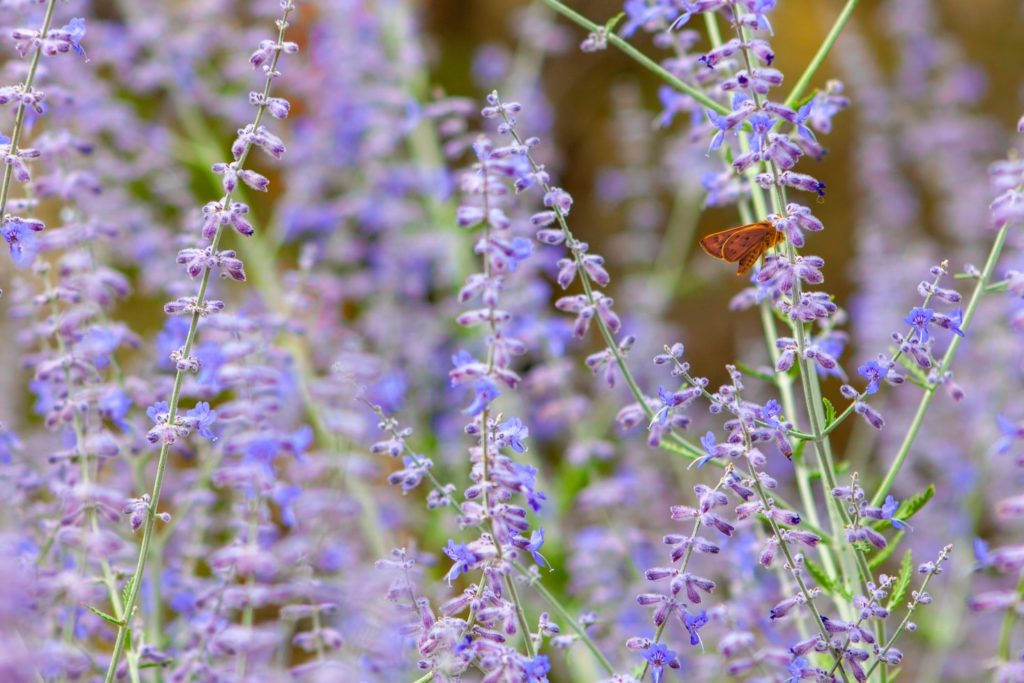 Photo by Raisa Nastukova RUSSIAN SAGE, OR SAGE, is a popular ornamental foundation plant that sets off midsummer garden borders and is hardy through autumn. A member of the mint family Lamiaceae, densely packed, tubular blossoms grow on long, square stems. Though related, Russian sage is not edible like the common kitchen herb, garden sage. They do attract hummingbirds, butterflies, and—be careful—bees. Russian sage has a pungent odor that repels deer, rabbit, and garden pests.
Photo by Raisa Nastukova RUSSIAN SAGE, OR SAGE, is a popular ornamental foundation plant that sets off midsummer garden borders and is hardy through autumn. A member of the mint family Lamiaceae, densely packed, tubular blossoms grow on long, square stems. Though related, Russian sage is not edible like the common kitchen herb, garden sage. They do attract hummingbirds, butterflies, and—be careful—bees. Russian sage has a pungent odor that repels deer, rabbit, and garden pests.
ASTERS
Symbol of love, daintiness
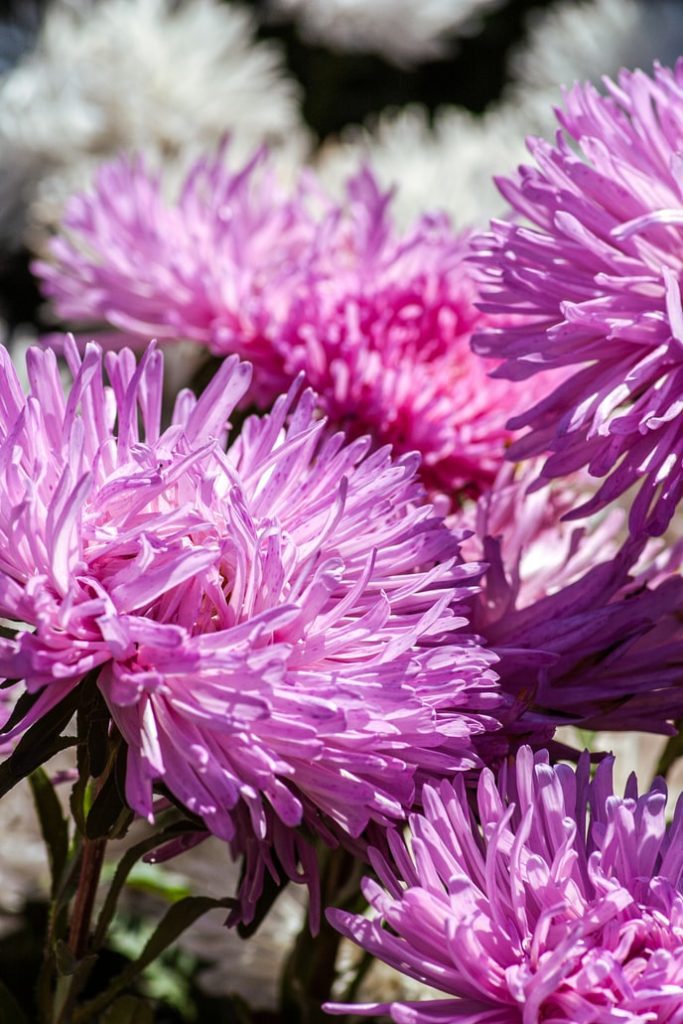 ASTERS ARE DELIGHTFUL, VERSATILE PERENNIALS with daisy-like flowers that range from white to blue to purple in color. They blossom in late summer and autumn, bringing a splash of color to borders, wildflower gardens, and rock gardens as summer blooms fade. Asters are also known as Michaelmas daisies since the late bloom season for the flower is September 29, the date of that Christian day of celebration. Most common among the many species and hybrids are the New England Aster (Symphyotrichum novae-angliae) and the New York aster (S. novi-belgii) and though not as flashy, a wild type that appeals to the wildflower gardener.
ASTERS ARE DELIGHTFUL, VERSATILE PERENNIALS with daisy-like flowers that range from white to blue to purple in color. They blossom in late summer and autumn, bringing a splash of color to borders, wildflower gardens, and rock gardens as summer blooms fade. Asters are also known as Michaelmas daisies since the late bloom season for the flower is September 29, the date of that Christian day of celebration. Most common among the many species and hybrids are the New England Aster (Symphyotrichum novae-angliae) and the New York aster (S. novi-belgii) and though not as flashy, a wild type that appeals to the wildflower gardener.
Growing asters from seeds can be difficult and uneven so it best to buy young plants and put them in the ground after the frost, in mid-to late spring. Space the individual plants between one and three feet apart, mulch to keep the soil cool and prevent weeds, and give them plenty of water in the early stages of growth to establish them.
BLACK-EYED SUSANS
Means “Justice” in the Language of Flowers
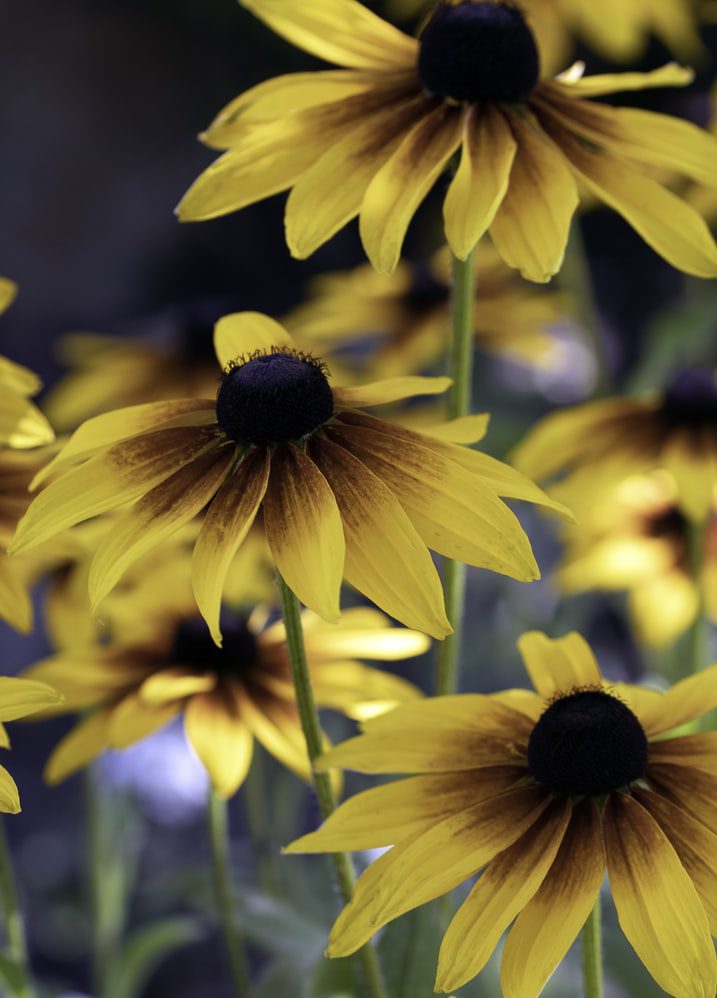
The Black-eyed Susan (Rudbeckia hirta) is a wildflower that is native to North America. A relative of the aster, its daisy-like flowerheads encircle a dark brown/purple “black eye” center. Its blooming season is from June to October. A hearty border planting, Black-eyed Susans tend to be territorial, so keep them in check lest they elbow out other of your garden flowers.
If you plant, wait until the soil has reached 70°F for best seed germination. The planting period is March to May and germination takes 7 to 30 days. Sow seeds by hand in moist, well-drained soil, spacing them 12-19” apart, and cover loosely with soil. Black-eyed Susans love the sun and will grow between one and three feet, sometimes taller.
REBLOOMING AZALEA
Temperance, passion. The Chinese symbol of womanhood.
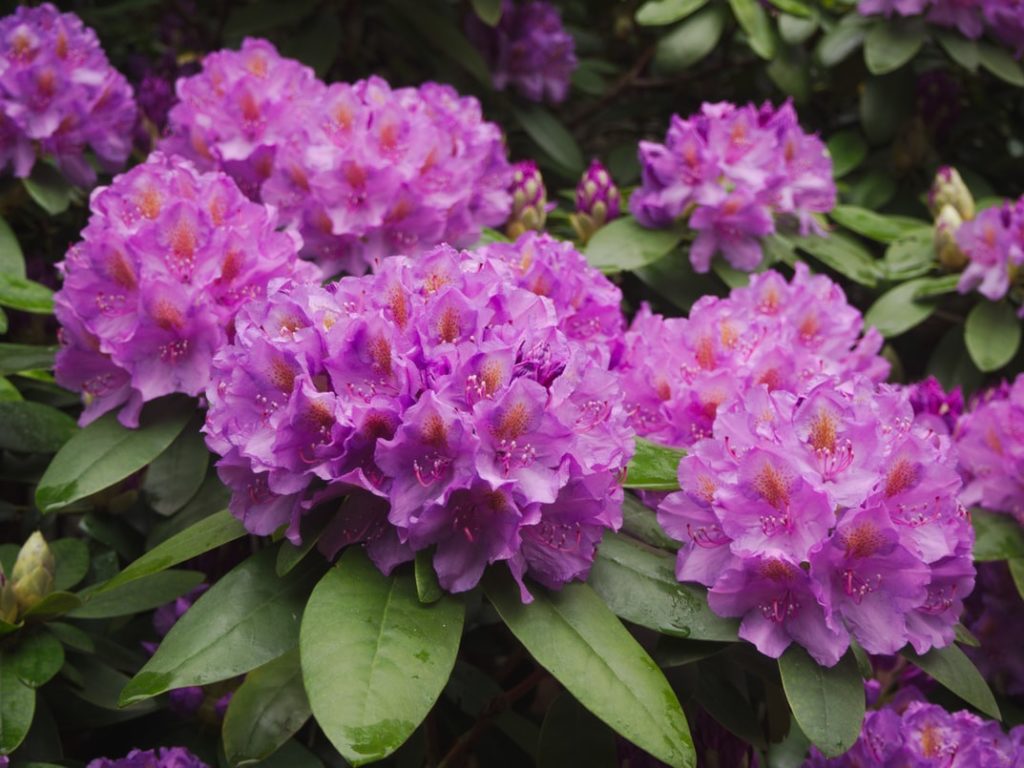 The word rhododendron comes from the Ancient Greek word rhódon, which means “rose”, and déndron, or “tree” and have been a staple of gardens here and abroad since the 1500s. Rhododendrons and azaleas are extremely hardy flowering shrubs found throughout North America. From genus Rhododendron, both species are foundation plants that blossom terrifically in late spring through some bloom in summer. There are thousands of varieties; some are low-growing ground cover that grows up to two feet while others can grow 25-feet tall. Both come in pink, red, yellow, orange, white, and purple. Their stunning, colorful, fragrant blooms, offset by large, emerald-green leaves can last through winter. The flowers are tubular, funnel, or bell-shaped. Rhododendrons tend to be finnickier than azaleas and are happiest in Zones 5 to 8.
The word rhododendron comes from the Ancient Greek word rhódon, which means “rose”, and déndron, or “tree” and have been a staple of gardens here and abroad since the 1500s. Rhododendrons and azaleas are extremely hardy flowering shrubs found throughout North America. From genus Rhododendron, both species are foundation plants that blossom terrifically in late spring through some bloom in summer. There are thousands of varieties; some are low-growing ground cover that grows up to two feet while others can grow 25-feet tall. Both come in pink, red, yellow, orange, white, and purple. Their stunning, colorful, fragrant blooms, offset by large, emerald-green leaves can last through winter. The flowers are tubular, funnel, or bell-shaped. Rhododendrons tend to be finnickier than azaleas and are happiest in Zones 5 to 8.
In Victorian times, the rhododendron has a most curious meaning. Indeed, it was a warning that the sender had dangerous intentions. There is a reason, however. In Ancient Roman times, Pompey the Great sent his army to conquer the lands of Mithridates VI, King of Pontus. Pompey, who was well-versed in the science of natural poisons, had honeycombs placed along the road the army would travel. The bees were of a particular type: they took their nectar from the rhododendron, which is extremely poisonous, and tasteless when fused in honey, causing hallucinations, blurred vision, drunkenness, fainting, or even death. The Roman army consumed the honey and Mithridates VI’s army attacked.
Happily, rhododendrons also have more pleasant meanings. They also symbolize vitality and beauty in general, but each color has its own connotation. Yellow rhododendrons convey happiness, friendship, and optimism. Red symbolizes passion, desire, and romantic love. And pink represents femininity and grace.
Rhododendrons and azaleas can blossom as early as March and as late as July, or even autumn, depending upon the variety and the location. They should be planted two- to six feet apart. Because of their shallow root system, they require moist soil and mulch to keep from drying out. Shrubs need a minimum of six hours of full sun daily to avoid mildew and increase blossoming. They should be planted in a sheltered area, like a windbreak, to avoid damaging winds and cold. In warm or hot regions (Zones 7 to 11), they should be planted in full shade.
AUTUMN FLOWER SEDUM
Tranquility
 Autumn flower, Sedum, is a perennial plant that comes in two varieties: low-growing sedum, which spread like ground cover and is only a few inches high, and upright sedum (Hylotelephium), which has thick, succulent leaves and clusters of star-shaped flowers like the low-growing variety but stands tall on fleshy stems. Also known as stonecrop, they are hardy, easy to care for, and suitable for any garden. You can plant sedum from seeds in early spring providing the soil is well-drained and nutrient-rich. You can also purchase them at a nursery in plugs or parts to transplant more readily into your garden.
Autumn flower, Sedum, is a perennial plant that comes in two varieties: low-growing sedum, which spread like ground cover and is only a few inches high, and upright sedum (Hylotelephium), which has thick, succulent leaves and clusters of star-shaped flowers like the low-growing variety but stands tall on fleshy stems. Also known as stonecrop, they are hardy, easy to care for, and suitable for any garden. You can plant sedum from seeds in early spring providing the soil is well-drained and nutrient-rich. You can also purchase them at a nursery in plugs or parts to transplant more readily into your garden.

